Disclosure: This article contains affiliate links. We may earn a commission from purchases at no extra cost to you, which helps our travel content.
The air in Udaipur carries stories – ancient whispers that dance between the faded haveli walls and ripple across the placid lakes. As I stood on a quiet rooftop at dawn, watching the first light illuminate the City Palace, I realized this wasn't the Udaipur that most travelers experience. Beyond the polished tourism corridors lies a labyrinth of narrow galis (alleyways) where the authentic pulse of the Lake City beats strongest. This is where I've spent my week – mapping forgotten pathways, collecting stories from elders, and discovering how this Rajasthani jewel mirrors my own search for ancestral connection.
The Forgotten Artisan Quarters
Tucked behind the bustling Jagdish Temple area lies a network of narrow lanes where Udaipur's artisans have worked for generations. Unlike the commercial shops that line the main roads, these family workshops maintain traditions that span centuries.
On my second morning, I followed the rhythmic sound of metal on metal down an unmarked alley near Ganesh Ghati. The path opened to a small courtyard where Prakash, a fifth-generation metalworker, crafted intricate silver pieces using techniques passed down since the Mewar dynasty. His fingers moved with the precision that only comes from decades of practice, reminding me of watching my grandmother's beadwork back in Manitoba.
'Tourists come for the palace,' Prakash told me with a knowing smile, 'but the soul of Udaipur lives in these workshops.'
I spent hours documenting his process with my mirrorless camera, which handled the low light of his workshop beautifully while remaining unobtrusive. The silent shutter proved invaluable for capturing candid moments without disrupting the sacred atmosphere of creation.
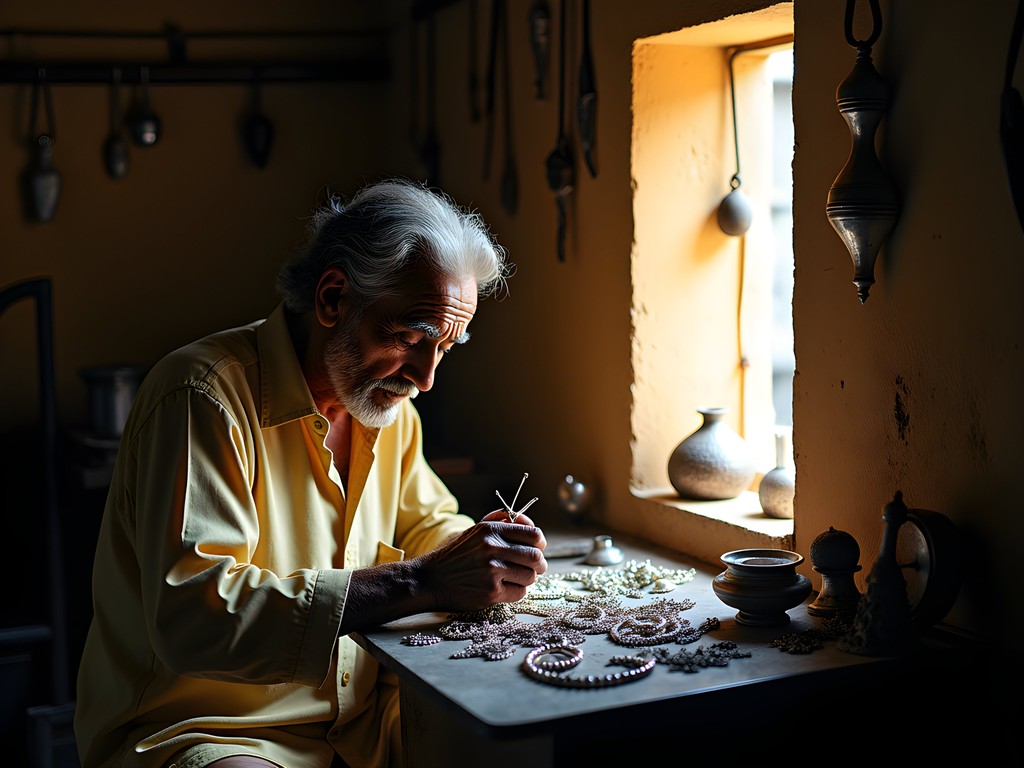
💡 Pro Tips
- Visit artisan quarters between 8-10am when craftspeople begin their daily work
- Bring small denominations of rupees to purchase directly from creators
- Ask permission before photographing artisans at work – a small purchase goes a long way toward goodwill
Dawn Rituals at Forgotten Ghats
While tourists flock to the famous Lake Pichola ghats, I discovered that locals prefer the quieter eastern shores for their morning rituals. Guided by Aditya, a university student I met at a local chai stall, I arrived at Ambrai Ghat well before sunrise, equipped with my travel journal and a thermos of masala chai.
Unlike the curated experiences at more popular spots, here the morning unfolds with authentic devotion. Elderly women in vibrant saris arrive first, placing marigold offerings on small shrines weathered by centuries of monsoons. Men in white kurtas perform yoga asanas that seem to mirror the movements my grandmother taught me – a reminder that across continents, humans seek similar paths to connect with something greater.
By 6:30 AM, the water's edge transforms into an informal community gathering. Priests chant mantras that echo across the water while children practice cricket in adjacent clearings. When I mentioned my Métis background to an elder named Govind, he nodded thoughtfully. 'Different words, same wisdom,' he said, explaining how water holds spiritual significance in both our traditions.
These dawn hours became my daily meditation practice in Udaipur, a sacred time to reflect on the parallels between this ancient city and my own heritage back in Canada's plains.
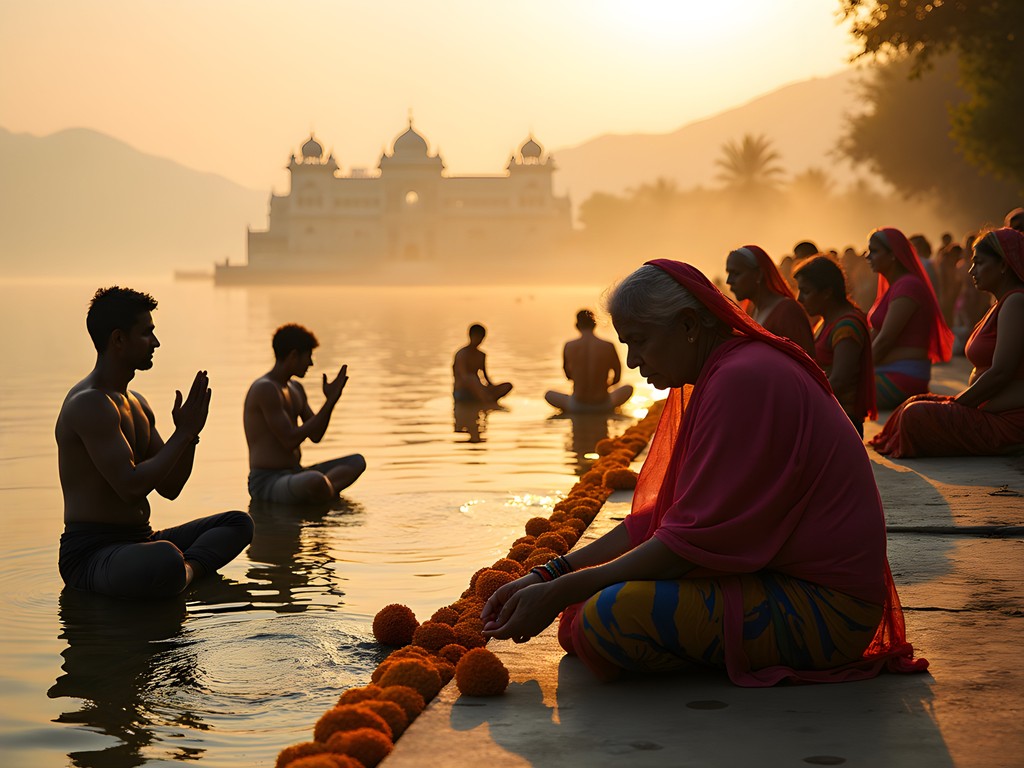
💡 Pro Tips
- Arrive at lesser-known ghats (like Ambrai or Gangaur) by 5:30 AM to witness the full morning ritual cycle
- Dress modestly and sit quietly to observe without disruption
- Bring a small offering of flowers if you wish to participate respectfully
The Haveli Whispers Trail
Udaipur's old city is dotted with havelis – historic mansions that once belonged to nobles and merchants. While some have been converted to hotels or museums, many remain private residences with extraordinary stories hidden behind their weathered facades.
I created what I call the 'Haveli Whispers Trail' – a self-guided walking route connecting seven lesser-known havelis that offer glimpses into Udaipur's layered past. Each morning, I'd mark my pocket map with notes and observations, slowly building a personal archive of the city's forgotten corners.
The most remarkable discovery was Bhatia Haveli near Chandpole. Unlike its more famous counterparts, this 300-year-old structure remains largely unchanged, with three generations of the same family still in residence. After several visits bringing small gifts of Canadian maple cookies (a surprisingly effective conversation starter), the patriarch, Mr. Bhatia, invited me to see their ancestral records room.
Inside, carefully preserved ledgers documented trade connections between Udaipur and Central Asia dating back to the 1700s. As someone who develops educational curricula, I was fascinated by these tangible connections between seemingly disparate cultures – evidence that globalization isn't merely a modern phenomenon.
'Our ancestors traveled much more than people realize,' Mr. Bhatia explained as he showed me faded photographs of family members in Persia and Tibet. 'The stories we're told about isolated civilizations are often political constructions.'
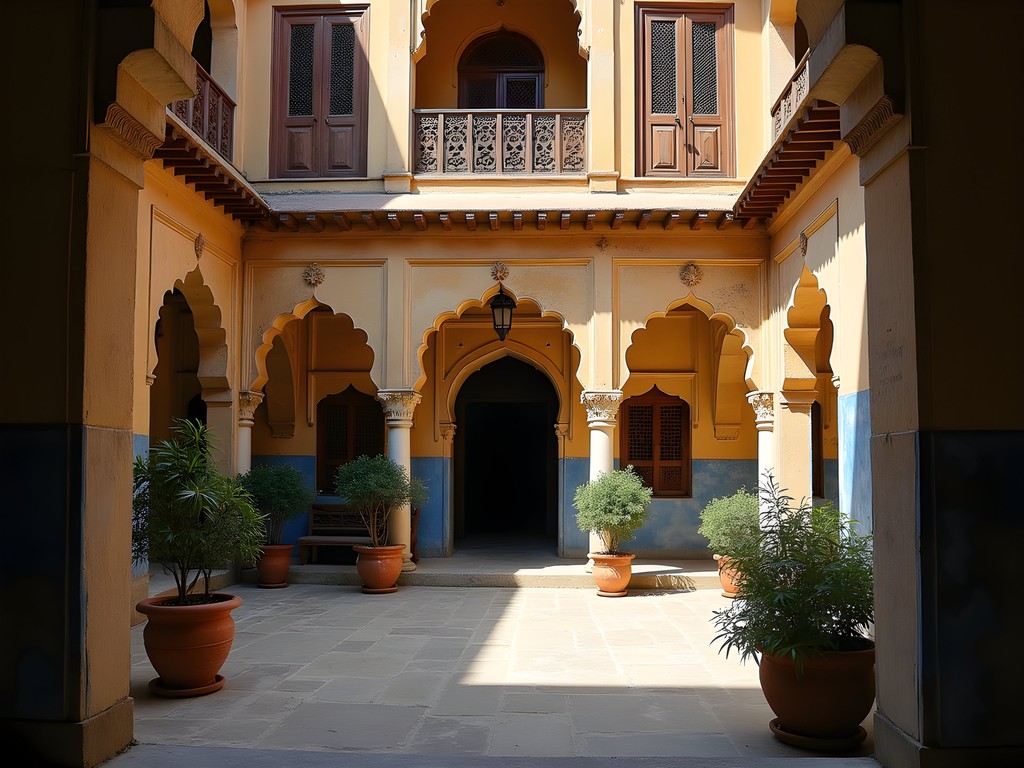
💡 Pro Tips
- Visit havelis during late afternoon (4-6pm) when families are more receptive to curious visitors
- Bring a small gift from your home country as a conversation starter
- Learn basic Hindi greetings to show respect when approaching private homes
Twilight Meditation at Neemach Mata Temple
While researching healing traditions in Udaipur, I heard whispers of evening meditation sessions at Neemach Mata Temple – a hilltop sanctuary overlooking the city that few tourists visit. Reaching it requires a 40-minute hike up uneven stone steps, deterring most visitors who prefer the convenience of more accessible sites.
I packed my travel backpack with essentials for the journey: water, a light shawl for the evening chill, and my headlamp for the descent after sunset. The trail winds through scrubby forest before emerging at a modest white temple complex that feels worlds away from Udaipur's tourist centers.
Arriving before sunset, I was welcomed by Lakshmi, an elderly caretaker who has maintained the temple grounds for over forty years. She explained that local residents gather here each evening for a simple meditation practice that combines elements of traditional Hinduism with regional folk beliefs.
'The city has forgotten many old ways,' she said, gesturing toward the sprawling development below, 'but up here, we remember.'
As twilight descended, about twenty locals arrived, sitting in concentric circles around the central shrine. No instructions were given – everyone simply knew the rhythm of this daily practice. The silence was profound, broken only by occasional chimes and the distant sounds of the city awakening to night.
I closed my eyes and felt an immediate connection to similar practices my grandmother had taught me on the Saskatchewan prairies – proof that humans have developed parallel methods for quieting the mind across vastly different landscapes and belief systems.
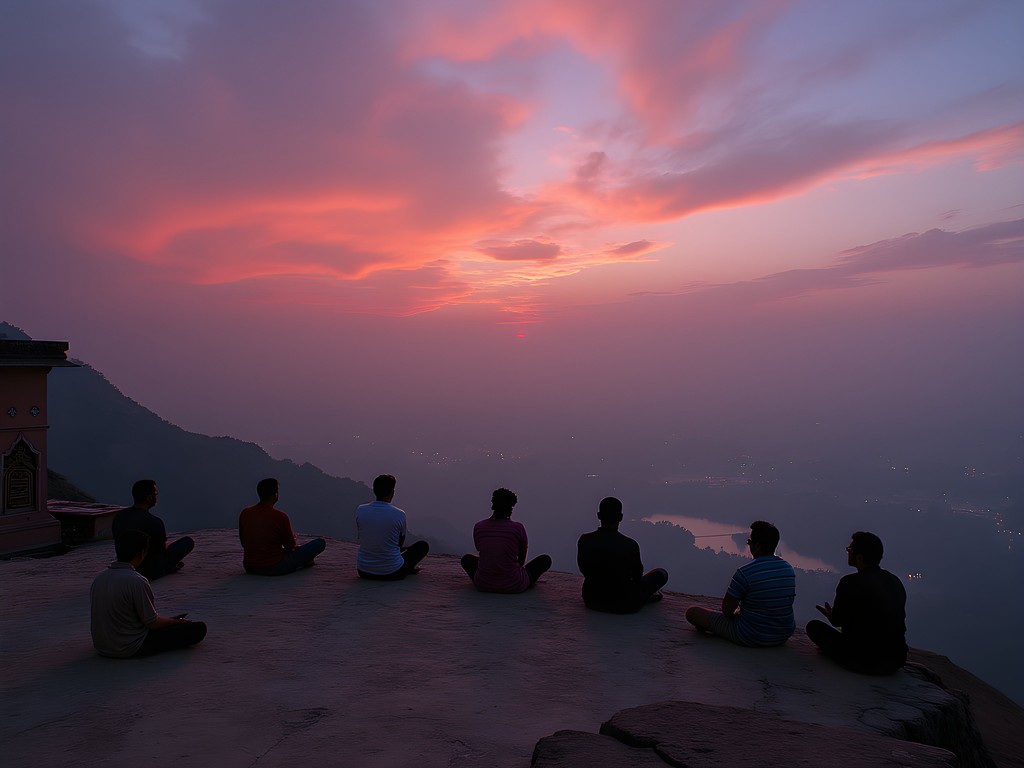
💡 Pro Tips
- Begin the hike at least 90 minutes before sunset to arrive with time to settle
- Bring a small cushion or shawl to sit comfortably during meditation
- Respect the silence and follow the lead of locals rather than asking questions during the ceremony
Navigating the Culinary Backstreets
Forget the restaurant recommendations in guidebooks. Udaipur's most transcendent culinary experiences hide in the maze of alleyways between Hathipole and the City Palace, where family kitchens have been serving the same specialties for generations.
Armed with my water purifier bottle (an absolute essential for street food adventures) and recommendations from local friends, I embarked on what became daily food pilgrimages to hidden stalls and home kitchens.
My most memorable discovery was Sharma Ji's kitchen – unmarked except for a small blue door in a residential lane near Jagdish Temple. Each afternoon, this seventy-year-old culinary master prepares just one dish: dal baati churma, a traditional Rajasthani meal of lentil curry, baked wheat balls, and sweetened crumbled bread. The preparation begins at dawn and serves only 30 people daily, chosen seemingly at random from those who gather outside.
After three failed attempts, I finally received the subtle nod that granted entrance. Inside, eight strangers sat cross-legged on floor mats while Sharma Ji served each component with ritualistic precision. No menu, no prices – you simply leave what you believe is fair payment in a small wooden box by the door.
'Food is medicine, medicine is food,' he told me when I complimented the complex spice blend in his dal. The statement echoed my grandmother's teachings about traditional foods of the plains – another bridge between seemingly disparate traditions.
I've documented these hidden culinary spots in my travel journal, creating a personal food map that traces Udaipur's history through its flavors. These aren't restaurants but rather cultural archives preserving techniques that predate written recipes.
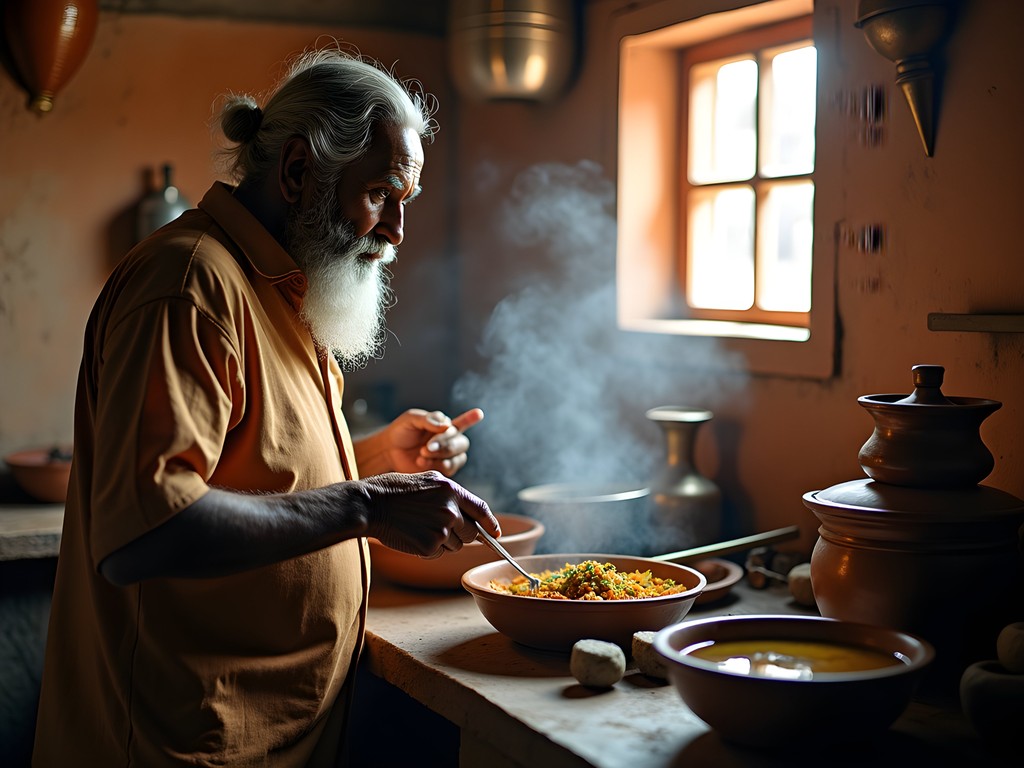
💡 Pro Tips
- Look for unmarked doors with small gatherings of locals around mealtimes
- Carry small denominations of cash as these places don't accept cards
- Learn the phrase 'Swad bahut accha hai' (The taste is very good) to express appreciation
Final Thoughts
As my week in Udaipur draws to a close, I find myself sitting on the rooftop of my modest guesthouse in the old city, watching the sunset paint the Lake Palace in hues of gold and amber. My journal pages are filled with maps of alleyways that don't appear on Google, names of families who've shared their stories, and notes connecting Udaipur's traditional practices to my own Métis heritage.
The true Udaipur doesn't reveal itself easily. It requires patience, respect, and willingness to step away from the prescribed tourist experience. For those willing to wander without destination, to sit in silence with locals during their daily rituals, and to approach the city with humility, Udaipur offers profound lessons about cultural preservation in rapidly changing times.
What strikes me most is how this ancient lake city mirrors my own journey of cultural rediscovery. Just as I've had to peel back layers of colonial history to reconnect with my Métis roots, Udaipur's authentic character requires looking beyond the glossy veneer of tourism to find the beating heart beneath.
I leave with more questions than answers – exactly as meaningful travel should be. These questions will inform my work developing educational curricula and deepen my understanding of how traditional knowledge persists despite modernization. Until we meet again, Udaipur. Your secret alleyways have stories I've only begun to hear.
✨ Key Takeaways
- Udaipur's authentic character lives in its back alleys and forgotten corners, not its tourist attractions
- Morning rituals at lesser-known ghats offer profound insights into local spiritual practices
- Hidden family havelis contain historical treasures and living connections to the past
- Traditional healing and meditation practices continue in hilltop sanctuaries overlooking the city
- The most authentic culinary experiences exist in unmarked home kitchens rather than restaurants
📋 Practical Information
Best Time to Visit
November to February (winter)
Budget Estimate
$30-50 USD per day for budget travelers
Recommended Duration
Minimum 5-7 days to discover hidden areas
Difficulty Level
Intermediate - Requires Comfort With Unguided Exploration And Basic Hindi Phrases

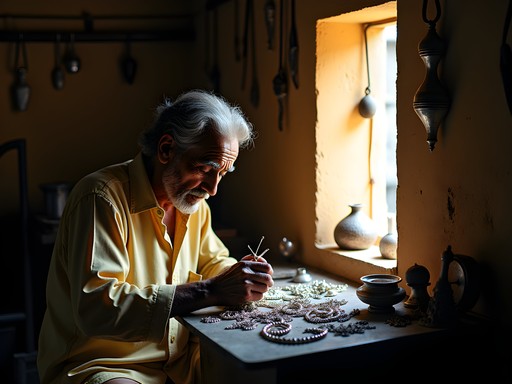

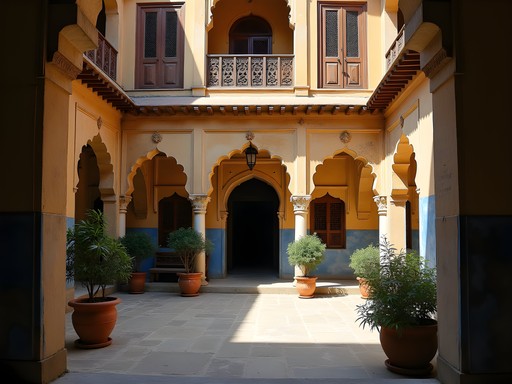
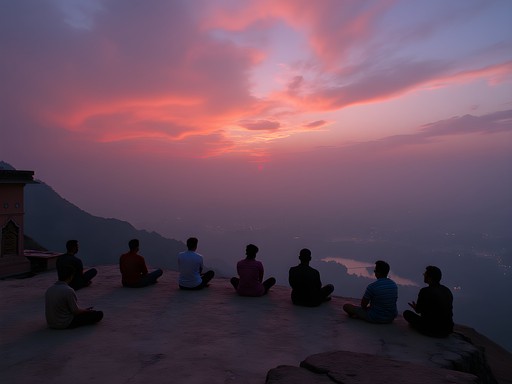
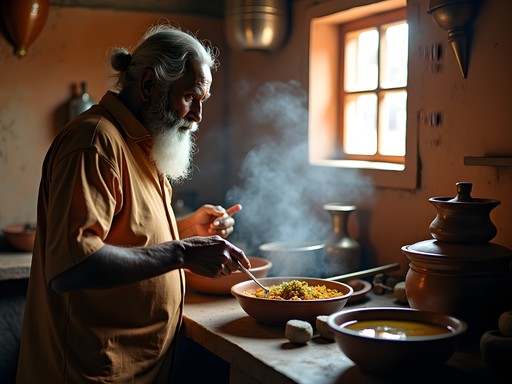








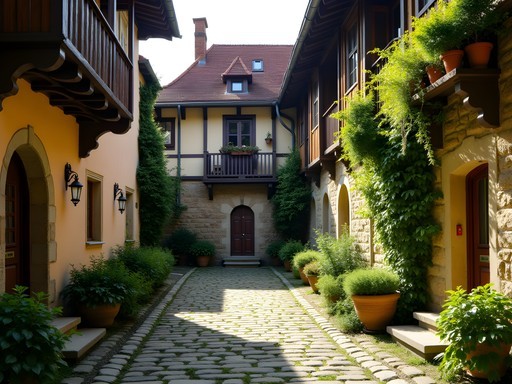
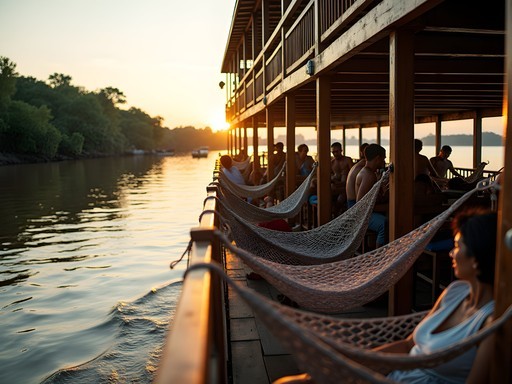
Comments
islandphotographer
Heading to Udaipur next month! How difficult was the hike up to Neemach Mata Temple? Worth doing for sunset specifically?
Donald Martin
It's about a 20-minute climb, moderate difficulty. Definitely worth it for sunset - the view of the lakes and city is spectacular! Just bring water and wear good shoes.
islandphotographer
Perfect, thanks for the info! Can't wait to capture those golden hour shots.
Nicole Russell
Donald, you've captured the soul of Udaipur that most tourists miss! I spent a month there in 2024 and discovered some of these same hidden corners. The artisan quarters were my absolute favorite - I spent hours watching the silversmiths work and ended up with some beautiful pieces. For anyone planning a visit, I'd recommend going during the off-season (September-October) when you can really experience these quiet moments without the crowds. I found my travel journal was perfect for sketching the intricate architectural details in those narrow alleys!
islandphotographer
Nicole, did you find it easy to photograph in those narrow alleys? I'm planning a trip and wondering about lighting conditions in the artisan quarters.
Nicole Russell
The lighting can be tricky! Early morning (around 8-9am) gives you beautiful golden light streaming through the alleys. A camera that handles high ISO well is definitely helpful for the indoor workshops.
islandtime431
Those sunset photos from Neemach Mata Temple are incredible! 😍
cityadventurer
This is exactly the kind of hidden gem content I live for! I was in Udaipur last year but completely missed these secret alleyways. The Haveli Whispers Trail sounds magical - was it easy to find on your own or did you need a local guide? Adding this to my list for when I return!
Donald Martin
Thanks! I actually stumbled upon most of these spots by just wandering and getting lost. The locals were incredibly helpful when I asked about old stories. Early morning (before 7am) is best for the forgotten ghats - hardly anyone around then!
cityadventurer
Getting lost is sometimes the best way to travel! Will definitely try the early morning ghat visit next time.
wanderlustadventurer
Heading to Udaipur next month! Saving this post!
globewanderer
Just got back from Udaipur last week and wish I'd read this before going! We did manage to find some hidden spots but missed the artisan quarters completely. The Neemach Mata Temple at twilight was definitely a highlight though - the view is unreal and there were hardly any other tourists there. One tip I'd add: we hired a local university student as our guide through our guesthouse, and he showed us some family-run workshops where they do miniature paintings. Ended up spending three hours learning about the traditional techniques and even tried painting a tiny elephant (failed miserably but it was so fun). Donald, your writing really captures that magical feeling Udaipur has at sunrise and sunset!
Claire Hawkins
This brought back so many memories! We took our kids (7 and 10) to Udaipur last year and followed a similar path to what you described in the Haveli Whispers Trail. The kids were absolutely enchanted by the stories our local guide told about the hidden courtyards. What made it special was bringing my illustrated India journal where we sketched the doorways and collected pressed flowers from each spot. The elderly women at the forgotten ghats were so kind to our children, showing them how to fold lotus leaf boats. For families heading there - the early morning walks are actually perfect with kids as the narrow lanes aren't crowded yet. Donald, did you try that tiny rooftop café near the artisan quarter that serves the saffron milk tea? My daughter still talks about it!
luckyninja
Taking kids there sounds amazing! Did they handle the heat okay? Planning a family trip next year!
Claire Hawkins
@luckyninja We went in November which was perfect! Morning activities, afternoon rest in AC, then evening lake walks. Bring lots of water and sun hats!
nomadbuddy
Been to those artisan quarters 3x. Go before 10am to see actual work happening. Later it's just tourist sales.
coolbackpacker
Your photos are INSANE!!! That shot of the sunset from Neemach Mata Temple is giving me serious wanderlust right now!!! 😍😍😍
winterqueen
The dawn rituals at the forgotten ghats sound incredible! How early did you have to get there? And is it appropriate for tourists to observe?
nomadbuddy
Was there in June. Get there by 5:30am. Totally fine to observe but stay respectful and don't photograph people praying.
winterqueen
Thanks for the tip! Early morning it is!
Venture X
Premium card with 2X miles, $300 travel credit, Priority Pass